To Find the Value of V for Different Values of U in Case of a Concave Mirror and to Find the Focal Length
Aim
To find the value of v for different values of u in case of a concave mirror and to find the focal length.
Apparatus
An optical bench with three uprights (zero end upright fixed, two outer uprights with lateral movement), concave mirror, a mirror holder, two optical needles (one thin, one thick), a knitting needle and a half metre scale.
Theory

Ray Diagram
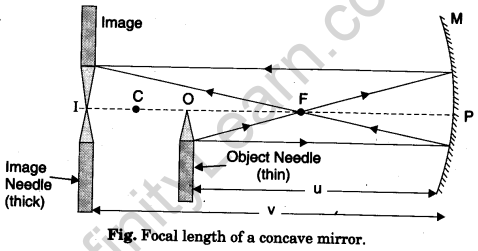
Procedure
To determine rough focal length
- Mount the concave mirror in mirror holder.
- Go out in the open and face the mirror towards distant tree or building.
- Obtain the image of the tree or the building on a white painted wall (screen) and move the mirror forward and backward to get a sharp image on the wall.
- Measure the distance between the mirror and the wall (screen). This will he equal to the rough focal length of the mirror.
[Note. Similar procedure is adopted for determining rough focal length of a convex lens.] To set the mirror - Place fixed upright near zero end of the optical bench and the two other uprights (with lateral movement) near the other end.
- Clamp the holder with mirror in the fixed upright keeping mirror face towards other end of the bench and surface perpendicular to its length.
- Make mirror surface vertical using levelling screws of the optical bench. (In final adjustment, the principal axis of the mirror must be horizontal and parallel to the optical bench),
- Note the position of the index mark on the base of mirror upright.
To set the object needle - Take the thin optical needle as object needle (O). Mount it in second upright.
- Move the object needle upright and clamp it at a distance (in full cm) nearly 1.5 times the obtained rough focal length of the mirror.
- Adjust height of the object needle to make its tip lie on horizontal line through the pole of the mirror.
- With left eye closed, see with the right open eye from the other end of the optical bench. An inverted and enlarged image of the needle will be seen Tip of the image must he in the middle of the mirror (If image is not seen, move object needle upright away from the mirror).
- Note the position of the index mark on the base of the object needle upright.
To set the image needle - Mount the thick optical needle (image needle) in third upright and move the upright near the other end of the optical bench.
- Adjust the height of the image needle so that its tip is seen in line with the tip of the image when seen with right open eye.
- Move the eye towards right. The tips will get separated . The image tip and the image needle tip have parallax.
- Remove the parallax as described [Section 7.08 (6)]. The parallax becomes removed tip to tip.
- Note the position of the index mark on the base of the image needle upright.
- Record all the positions of the index marks in the table against observation 2.
To determine index correction - Find index correction for distance between pole of mirror and tip of the object needle and also for distance between pole of mirror and tip of the image needle as described. [Section 7.10 (c)]
- Move object needle upright towards mirror in steps of 1 cm to get observation 2 and 1. Repeat the experiment.
- Move object needle upright away from mirror (from position of observation 2) in steps of 1 cm to get observations 4, 5 and 6. Repeat the experiment.
- Record all the observations as given ahead.
[Note. Order of observations, is kept, 3,2,1,4,5 and 6 to ensure that object always lies between distance f and 2f, even when found rough focal length may be too rough.]
Observations
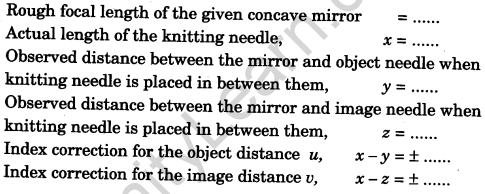
Table for u,v and 1/u,1/v
Calculations
Calculations of focal length by graphical methods
(i) u-v Graph. Select a suitable but the same scale to represent u along x’-axis and u along Y’-axis. According to sign conventions, in this case u and v both are negative. Plot the various points for different sets of values of u and v from’ the observation table. The graph comes out to be a rectangular hyperbola as shown in figure.
Draw a line OA making an angle of 45° with either axis (i.e., bisecting ∠Y’ OX’) and meeting the curve at point A. Draw AB and AD perpendicular on X’- and Y’-axes respectively. The values of u and v will be same for point A. So the coordinates of point A must be (2 f, 2 f) because for a concave mirror u and v are equal only when the object is placed at the centre of curvature.
Hence, u = v = R = 2 f
Explanation


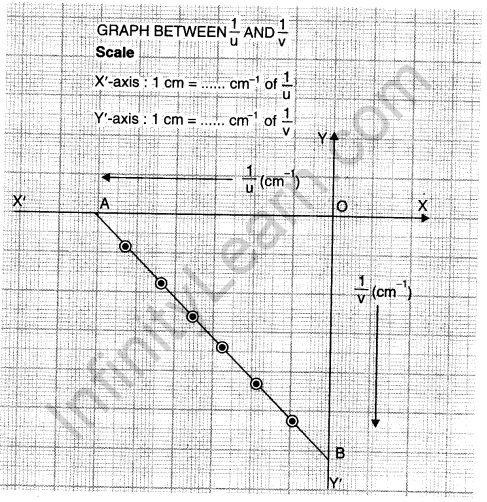

Explanation
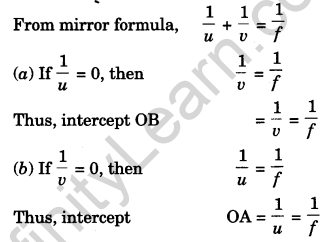
(iii) Another u-v Graph. Select a suitable but the same scale to represent u along X’-axis and v along Y’-axis. Mark the points at distances u1, u2, u3,…….. etc. along the OX’-axis
and the corresponding points at distances v1, v2, v3,…….. etc. along the OY’-axis for different sets
of observations from the table.
Draw straight lines joining u1 with v1, u2 with v2, u3 with v3 etc. These lines will intersect at a point K as shown in figure below. Draw KL and KM perpendiculars on X’- and Y’-axes respectively.
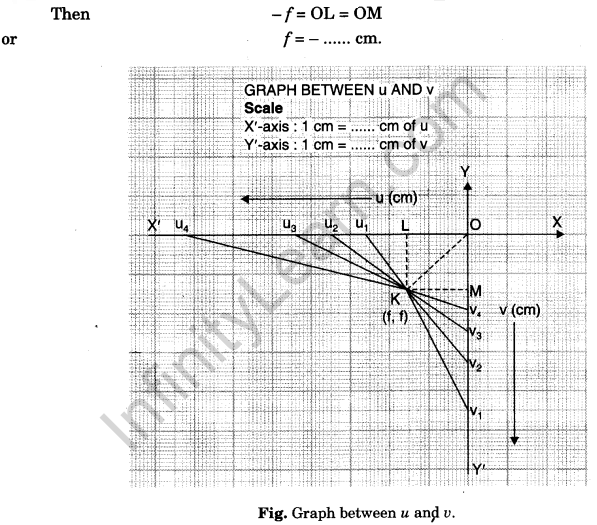
Explanation
![]()
Also satisfied by extreme sets (f,∞) and (∞,f) of u and v values. The straight lines corresponding to extreme sets intersect at a point (K) having co-ordinates (f. f). If set (u1 v1), (u2, v2),
satisfy the mirror formula then straight lines corresponding to these sets will also pass through the point K(f.f).
Hence, co-ordinates of the point K obtained from the observed sets of u and v values give value of f.
![]()
Note. It will be better to choose any four suitable sets of (u, v) values from the observation table. All the six sets of observations may complicate the graph.
Result

Precautions
- Principal axis of the mirror should be horizontal and parallel to the central line of the optical bench.
- The uprights should be vertical.
- Tip to tip parallax should be removed between the needle I and image of the needle O.
- To locate the position of the image the eye should be at least 30 cm away from the needle.
- Tips of the object and image needles should lie at the same height as that of pole of the concave mirror.
- Index correction for u and v should be applied.
Sources of error
- The uprights may not be the vertical.
- Parallax removal may not be perfect.




